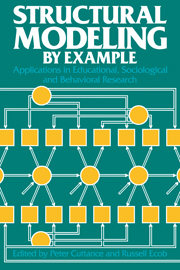Book contents
- Frontmatter
- Contents
- Preface
- List of contributors
- 1 Introduction
- 2 An overview of structural equation modeling
- 3 Field dependence and the differentiation of neurotic syndromes
- 4 High school seniors' reports of parental socioeconomic status: black–white differences
- 5 Modeling the hierarchical structure of learning
- 6 A study of longitudinal causal models comparing gain score analysis with structural equation approaches
- 7 Some structural equation models of sibling resemblance in educational attainment and occupational status
- 8 Applications of structural equation modeling to longitudinal educational data
- 9 The robustness of maximum likelihood estimation in structural equation models
- 10 An inquiry into the effects of outliers on estimates of a structural equation model of basic skills assessment
- 11 Testing structural equation models
- 12 LISREL models for inequality constraints in factor and regression analysis
- 13 Issues and problems in the application of structural equation models
- Appendix
- Glossary
- Index
9 - The robustness of maximum likelihood estimation in structural equation models
Published online by Cambridge University Press: 12 January 2010
- Frontmatter
- Contents
- Preface
- List of contributors
- 1 Introduction
- 2 An overview of structural equation modeling
- 3 Field dependence and the differentiation of neurotic syndromes
- 4 High school seniors' reports of parental socioeconomic status: black–white differences
- 5 Modeling the hierarchical structure of learning
- 6 A study of longitudinal causal models comparing gain score analysis with structural equation approaches
- 7 Some structural equation models of sibling resemblance in educational attainment and occupational status
- 8 Applications of structural equation modeling to longitudinal educational data
- 9 The robustness of maximum likelihood estimation in structural equation models
- 10 An inquiry into the effects of outliers on estimates of a structural equation model of basic skills assessment
- 11 Testing structural equation models
- 12 LISREL models for inequality constraints in factor and regression analysis
- 13 Issues and problems in the application of structural equation models
- Appendix
- Glossary
- Index
Summary
Introduction
General methods for the analysis of covariance structures were introduced by Joreskog (1970, 1973). Within the general theoretical framework it is possible to estimate parameters and their corresponding standard errors and to test the goodness-of-fit of a linear structural equation system by means of maximum likelihood methods. Although other methods of estimating such models (least squares procedures, instrumental variable methods) are available, we do not discuss them here.
For an introduction to the general model the reader is referred to Chapter 2 and for more detailed statistical discussions to Jöreskog (1978, 1982a, b). The LISREL model considers a data matrix Z(N × k) of N observations on k random vaŕiables. It is assumed that the rows of Z are independently distributed, each having a multivariate normal distribution with the same mean vector μ and the same covariance matrix ∑; that is, each case in the data is independently sampled from the same population. In a specified model there are s independent model parameters co, to be estimated. For large samples the sampling distribution of the estimated parameters ŵi and the sampling distribution of the likelihood ratio estimate for goodness-of-fit are approximately known, provided that the preceding assumptions hold. Under the same conditions the standard errors of the estimated parameters seŵi are also known asymptotically. In the following, standardized parameter estimates are defined by ŵ*i = (ŵi − ωi)/seŵi. For large samples the sampling distribution of ŵ*i is approximately standard normal, and the goodness-of-fit estimate has an approximate chi-square distribution with k(k + 1)/2 – s degrees of freedom.
- Type
- Chapter
- Information
- Structural Modeling by ExampleApplications in Educational, Sociological, and Behavioral Research, pp. 160 - 188Publisher: Cambridge University PressPrint publication year: 1988
- 17
- Cited by



